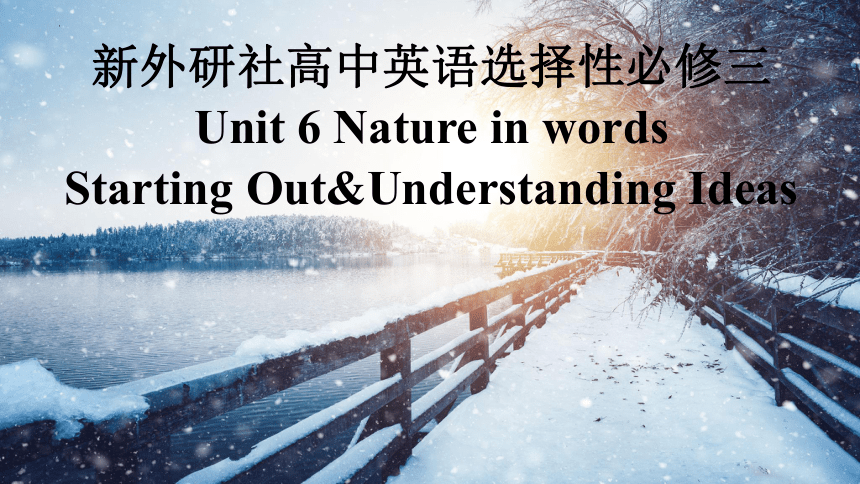(
课件网) 新外研社高中英语选择性必修三Unit 6 Nature in words Starting Out&Understanding Ideas Starting Out Q. What literary forms(文学形式)do you know literary forms poems novels essays letters travel journals dramas folk tales ① Watch the video and answer the questions. 1 What literary forms are mentioned in the video Poems, letters (home), travel writing/journals, essays and novels 2 What other nature writers do you know of Tell the class about him or her. 1. What images are used to symbolise nature 2. What message does the poem try to convey Listen and read the poem by Emily Dickinson. Answer the questions. “Nature “ Is What We See by Emily Dickinson “Nature” is what we see- The Hill- the Afternoon- Squirrel- Eclipse – The Bumble bee- Nay- Nature is Heaven- Nature is what we hear- The Bobolink – The Sea- Thunder- the Cricket- Nay- Nature is Harmony- Nature is what we know- Yet have no art to say- So impotent Our Wisdom is To her Simplicity. Nature is symbolised by simple images of ① a_____ and ② f_____, which are in turn symbolic of the poet’s thoughts and feelings about the simplicity of nature. Nature is also symbolised in a metaphorical sense when it is described as “H_____” and “H_____”. nimals eatures eaven armony The message of the poem is that although what we see and hear in nature appears to be simple, within that simplicity lie great beauty, mystery and magnificence that humans cannot truly appreciate or capture in their art. Emily Dickinson (1830-1886) The poem of Emily Dickinson are considered to be some of the most original and defining works of American poetry. With a childhood love of reading and exploring nature, she grew up to be a keen observer of the people and places around her, and many of her poems convey a deep appreciation of the mystery and beauty of the natural world. 壹 自然,是我们所见 山峦,午后的光景 松鼠,日食,大黄蜂 自然,甚至,是乐园 贰 自然,是我们所闻 食米鸟叫,大海喧嚣 雷霆,蟋蟀 自然,甚至,是和声 叁 自然,是我们所知 我们却无法说明 要道出她的淳朴 我们的智慧无能 “Nature” Is What We See Understanding Ideas 第一场雪 What is your understanding of this title? Share with others First Snow Brainstorming:Before learning this passage, what ideas come to your mind 1. landscape 2. town 3. ... John Boynton Priestley (1894-1984) was bom in the English county of Yorkshire, and knew early on that he wanted to become a writer. When World War 1 broke out, Priestley joined the army, and escaped death on a number of occasions. After the war, he gained a degree from Cambridge University, and then moved to London, where he worked as a freelance writer. During World War II, he presented a weekly radio programme, w hich became immensely popular. Priestley wrote many successful articles, essays, novels and plays, but is best remembered for his play An Inspector Calls. Priestley loved snow and expressed a desire to live in a country where it often snowed. Le ... ...

